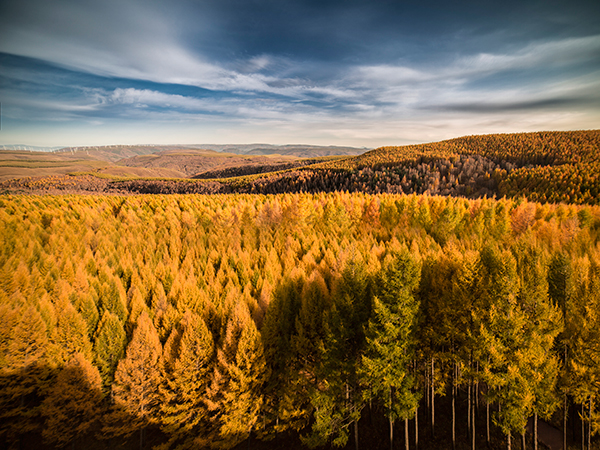
Larch forest in the Great Khingan Mountains is part of the northern Eurasia coniferous forest, is the continuation of the south part which belong to the coniferous forest in the southern East Siberia. Down part of mountain is dense brown forest soil, the upside of mountain is brown coniferous forest soil, all present acidic reaction. The vegetation here has obvious vertical zoning phenomenon. At an altitude of 600 meters below the valley is modern Mongolian larchen forest. Other trees are black birch, aspen, linden, northeast China ashtree, amur cork tree, etc. Understory shrubs are two lespedeza, hazelnuts, mandshurica, etc.
Geography
The Great Khingan Mountains is important mountains in northeast China. Heilongjiang south is the source of Ergun River and the cradle main tributary of Nenjiang River. From the Heilongjiang River, move towards north-east and north-north to east direction; end in the south of Xar Moron River valley. Between northern latitude 43°- 53°30 ‘, east longitude 117 ° 20 ‘- 126 °. It is about 1200 kilometers, 200-300 km wide, covers an area of 8.44 square kilometers. Most part is 1100 to 1400 meters above sea level. High Mountain is asymmetrical, and it is high in northwest but southeast is low with flat east and steep west, flatly transit to the Mongolian plateau of its west, the east steep side is down to the northeast plain step by step, the mountain is present a image of wide north but narrow south. With general Lesser Khingan Mountain is bounded in Nenjiang river valley, but also can be dividing as Beian-Aihui Line.
Climate
Great Khingan Mountain elevation is about 600 to 1000 meters; there are some mountains near 1400 meters. Average annual temperature is 1.2
℃, below 5 ℃, the average July temperature is 16 to 20 ℃, the annual accumulated temperature (for the sum of daily average temperature which is higher than 10 ℃) for 1100-1700 ℃, frost-free period of 70 to 100 days, annual rainfall is 400-600 mm. Because of the low temperature growing environment, air relative humidity is bigger. Suitable for forest growth, here is China’s only growing area of cool temperature zone of deciduous conifers (larch), larch forest here has a large coverage and of a pure consistence.
Best time to go
Greater Khingan Mountains region situated in China’s northernmost, with short winter but long summer, especially at Mohe River, Los ancient river region, more than seven months in winter, the sunshine time is very short, summer is only 2 months or so, however, from July to August each year, sunshine time is 17 hours.
At Mohe region, the annual average temperature of 4
℃ below zero, the winter temperature more than 40 ℃ below zero, however, because of the large forest wind, although the temperature is very low, it is not so terrible as people think it will be. Travel here in winter, visitors can wear cotton, cotton trousers, jacket, plus a set of hats, scarves and gloves.
Transport
Most visitors go to the Greater Khingan Mountains region, the most important is to visit to “the arctic village” at Mohe. Usually tourists arrived in Harbin by train, then take train from Harbin to Jiagedaqi for about 12 hours, and then from Jiagedaqi transfer to train more than 10 hours arrived at Mohe Township, more than two hours to Los ancient river village
Accommodation
Jiagedaqi, the capital of the Greater Khingan mountains region, is equipped with a variety of commercial hotel and authority guest house, accommodation is more convenient. At Mohe county Xilinji town there is Tourist Administration, where can take tourists to visit the arctic village, but Xilinji town has no hotels and guest houses.

